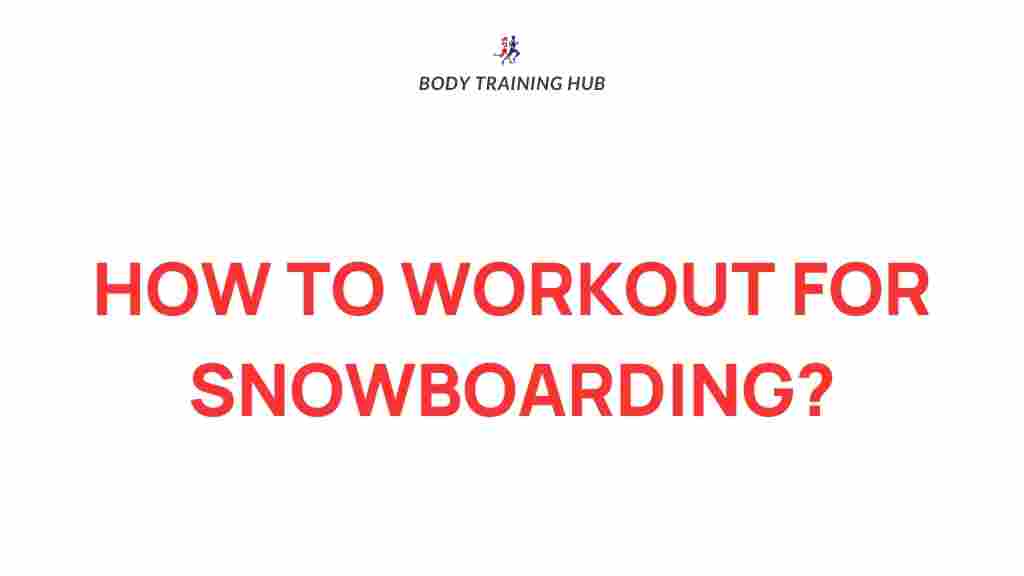Unleash Your Snowboarding Potential with These Expert Workout Tips
Snowboarding is one of the most exhilarating winter sports, combining speed, skill, and style on the slopes. However, to truly excel in snowboarding, you need more than just passion; you need a dedicated workout and fitness regimen that enhances your strength, endurance, and overall performance. This article will guide you through expert tips and techniques to enhance your training for snowboarding, ensuring you hit the slopes with confidence and power.
Understanding the Importance of Fitness for Snowboarding
Snowboarding requires a unique blend of physical capabilities. From explosive strength to cardiovascular endurance, the demands of the sport can be intense. Here are the key fitness components you need to focus on:
- Strength: Essential for maintaining control and balance while navigating varied terrains.
- Endurance: Vital for enduring long runs and maintaining energy levels throughout the day.
- Flexibility: Important for preventing injuries and allowing for a range of motion in maneuvers.
- Balance: Crucial for stability on the board, especially during tricks and turns.
Step-by-Step Workout Plan for Snowboarding Fitness
To maximize your snowboarding performance, follow this step-by-step workout plan tailored to the specific needs of winter sports enthusiasts.
1. Warm-Up Routine
Always start your workout with a dynamic warm-up to prepare your muscles and joints. Here’s a simple routine:
- High knees – 1 minute
- Butt kicks – 1 minute
- Arm circles – 30 seconds each direction
- Leg swings – 30 seconds each leg
2. Strength Training Exercises
Focusing on lower body strength is crucial for snowboarding. Incorporate these exercises into your weekly routine:
- Squats: 3 sets of 10-15 reps
- Deadlifts: 3 sets of 8-12 reps
- Lunges: 3 sets of 10 reps per leg
- Box Jumps: 3 sets of 10 reps
These exercises will help build the leg strength necessary for powerful turns and jumps.
3. Endurance Building
To improve your cardiovascular fitness for extended runs, try the following:
- Running: 30-45 minutes, 2-3 times a week.
- Cycling: 45 minutes to 1 hour, focusing on maintaining a steady pace.
- Interval Training: Incorporate sprints (30 seconds on, 1 minute off) into your routine.
4. Flexibility and Mobility Work
Incorporate stretching and mobility exercises to enhance flexibility:
- Hamstring stretches: 30 seconds each leg
- Hip openers: 30 seconds each side
- Shoulder stretches: 30 seconds each arm
5. Balance Training
Improving your balance is essential for snowboarding. Try these exercises:
- Single-leg stands: Hold for 30 seconds on each leg.
- Bosu ball squats: 3 sets of 10-12 reps.
- Balance board exercises: 10-15 minutes of various movements.
Incorporating Cross-Training
Cross-training can significantly enhance your snowboarding performance. Incorporate activities that complement your training:
- Yoga: Improves flexibility and core strength.
- Surfing or skateboarding: Enhances balance and coordination.
- Rock climbing: Builds upper body strength and grip.
Nutrition for Optimal Performance
Fueling your body correctly will enhance your workout and snowboarding performance. Focus on:
- Complex carbohydrates: Whole grains, fruits, and vegetables for energy.
- Lean proteins: Chicken, fish, and legumes for muscle recovery.
- Healthy fats: Nuts, avocados, and olive oil for sustained energy.
Stay hydrated and consider a pre-workout snack rich in carbohydrates for an energy boost before you hit the slopes.
Troubleshooting Common Workout Challenges
Even with the best intentions, you might face obstacles during your training. Here are some common challenges and solutions:
1. Lack of Motivation
If you find yourself lacking motivation, try the following:
- Set specific and achievable goals.
- Workout with friends or join a class.
- Track your progress to see improvements over time.
2. Overtraining
Be cautious of pushing too hard. Signs of overtraining include:
- Persistent fatigue
- Decreased performance
- Increased injuries
If you experience these symptoms, consider taking a break or adjusting your training schedule.
3. Boredom with Routine
If your workout feels stale, shake things up by:
- Trying new exercises or classes.
- Changing your workout environment.
- Setting new challenges or participating in competitions.
Conclusion
By focusing on strength, endurance, flexibility, and balance through a dedicated workout program, you can significantly enhance your snowboarding skills. Remember to fuel your body with proper nutrition and stay motivated by tracking your progress. Embrace the process, and soon you’ll be unleashing your full potential on the slopes. For more tips on winter sports training, feel free to check out this resource.
Get ready, gear up, and enjoy the thrill of snowboarding like never before!
This article is in the category Strength & Recovery and created by BodyTraining Team
